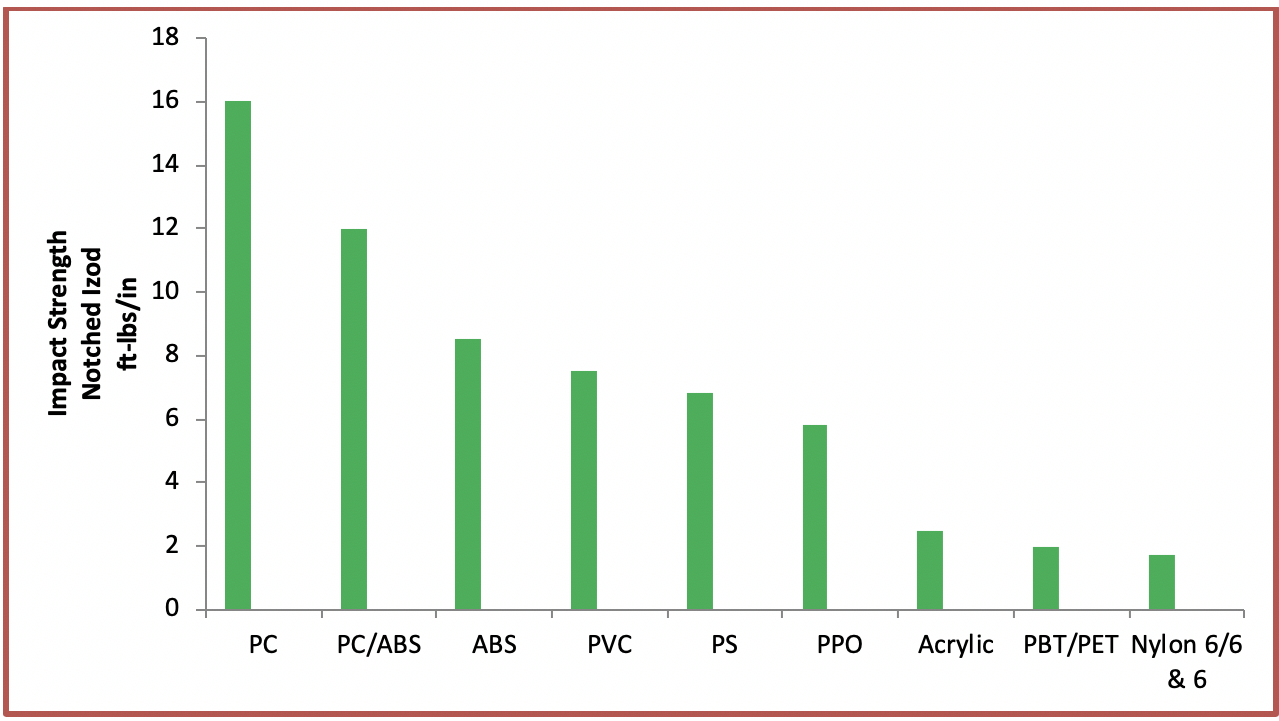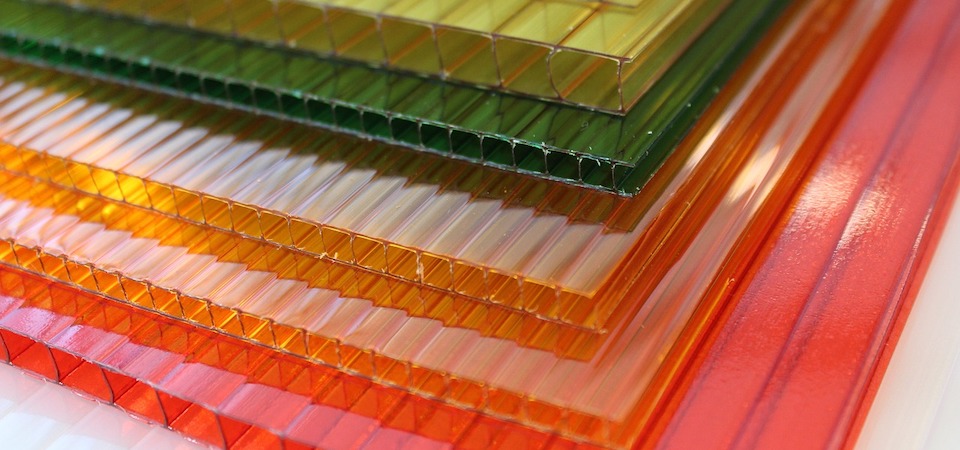All About Polycarbonate (PC) Plastic
Polycarbonate or “PC” is a highly useful engineering thermoplastic. It has desirable physical properties such as transparency, high toughness, and very good heat resistance. The raw material of polycarbonate allows similar levels of internal light transmission as those of glass. Polycarbonate also has a high impact resistance and is very useful in applications which call for a tough material that is also transparent. Examples for such applications include bullet-proof glass or protective eye gear.

Polycarbonate can maintain its rigidity across a wide range of temperature: as low as -20oC and as high as 140oC. It can be easily combined with flame retardant materials without major degradation. Being a thermoplastic material, it has a melting point of 150oC. It can be heated to that temperature, cooled, and then reheated again without any significant degradation. The ability of polycarbonate to liquefy at 150oC makes it a good fit for injection molding.
History of Polycarbonate
The earliest record of polycarbonate creation dates back to 1898. It was at this time that a German scientist named Alfred Einhorn attempted to make polycarbonate while working at the University of Munich. What followed was 30 years of laboratory research. But the research did not lead to any major commercialization and was abandoned.
Then in 1953, Hermann Schnell at Bayer in Germany created the first linear polycarbonate and soon filed a patent. Within a week of Bayer’s creation, Daniel Fox at General Electric in the USA also created polycarbonate and submitted a patent with the US authorities. Bayer was given priority and it started commercial production in 1958 under the trade name Merlon. In 1960, General Electric also started polycarbonate production under the trade name Lexan.
Today, the global demand for polycarbonate exceeds 4 million tons per annum.
Manufacturing of Polycarbonate
Polycarbonate is named so because it is a polymer which contains carbonate groups. It is produced by reacting bisphenol A (BPA) and Phosgene. The bisphenol is produced by condensation of phenol with acetone.
Polycarbonate is known to be very pliable. It can be formed at room temperature in a manner similar to aluminum sheets, without breaking or cracking. Sheet metal techniques can be used to process and form polycarbonate. This makes it an excellent material for making prototypes because polycarbonate can be bent at room temperatures. It is not brittle like acrylic. It is also very useful in making prototypes where transparency and non-conductivity are essential. Sheet metal cannot offer both those properties.
Different Grades of Polycarbonate
Polycarbonate is available in different grades depending upon the application where it is to be used. The method of preparation for each grade is different. Polycarbonate is available in grades such as reinforced, flame retardant, film, crack-resistant, branched, etc. Certain blends of polycarbonate are used in specific industries. The blends are made with ABS or polyester. Examples of various processing methods for polycarbonate include:
- Extrusion
- Injection Molding
- Structural Foam Molding
- Blow Molding
- Vacuum Forming
Applications of Polycarbonate
Automotive: Polycarbonate is strong, lightweight, and durable. Hence, it is used to make sunroofs in cars. It is also used to make dashboards, head lamp lenses, bumpers and various body panels. Luxurious car interiors are made using polycarbonate.
Compact Storage: Polycarbonate is used to make CDs, DVDs, and Blue Ray discs via the injection molding technique.
Electrical: Polycarbonate is a good insulator and heat resistant as well. It is used in telecommunications hardware. It also serves as a dielectric in high-stability capacitors. Certain LED screens are now being made with polycarbonate because it is lighter than glass.
Eyewear: Polycarbonate has high impact resistance and low scratch resistance (when coated). So, it is used to make contact lenses and protective eyewear. A hard coating is applied to eyewear lenses to make it scratch resistant.
ATM machines: The front panel of cash dispensing ATM machines are made with polycarbonate. They are normally made using aluminum, but polycarbonate results in cost savings.
Mobile phones: The high impact resistance of polycarbonate makes it a great candidate for producing mobile phone panels. Mobile phones must have a strong outer casing to prevent damage from accidental drops. Polycarbonate offers the necessary solution.
Baby drinking bottles: BPA free polycarbonate is used to manufacture baby water and milk bottles. High impact resistance makes these bottles unbreakable.
Police riot gear: Riot and protective gear used by law enforcement agencies is made from polycarbonate due to the toughness and high impact resistance that it offers.
Swimming: Polycarbonate is used to make swimming goggles and SCUBA diving masks. This polycarbonate is treated with anti-scratch coating for durability and high utility.
Polycarbonate Prototypes using CNC and 3D printer machines
CNC machines
Polycarbonate is a great material for use with CNC machines. It comes in sheet or round stock and works well with a machining process that involves a mill or lathe. It is transparent and has high impact resistance along with toughness, all of which translates into great machinability. Polycarbonate used with CNC machines is normally black, white, or transparent. Sometimes, additional processing of the polycarbonate is required after it has been used with a CNC machine in order to remove any tool marks and scuffs.
3D Printing
Polycarbonate is also available in a filament form which can be used with 3D printers to create prototypes using computer-aided design files. As polycarbonate is a thermoplastic which can be melted and then cooled without degradation, it is used with 3D printers using the FDM process. The 3D printer basically heats the polycarbonate filament and then deposits it according to the design of the prototype. Normally, the color of polycarbonate used for 3D printing is white. However, certain Polycarbonate/ABS blends are also used at times for 3D printing on an FDM machine.
Disadvantages of Polycarbonate
- Material contact of certain types of polycarbonate with water can lead to a process called hydrolysis where Bisphenol A is released. This makes polycarbonate use in food-related applications potentially hazardous. BPA-free polycarbonates are a must in food and beverage related applications.
- Polycarbonate has low resistance to scratching. Hence, in applications such as contact lenses or eye-wear, it needs to be coated with some kind of scratch-resistant material to prevent scratching.
- Polycarbonate does not offer very high resistance to chemicals and organic solvents. It tends to deteriorate when exposed to such chemicals and solvents.
- Polycarbonate is more expensive to produce than ABS (acrylonitrile butadiene styrene). ABS is a general purpose plastic resin. So for certain applications, polycarbonate will be expensive in terms of raw material costs.
Properties and Specs
| Property Type | Detail |
| Scientific Name | Polycarbonate (PC) |
| Resin Identification Code | Other (7) |
| Chemical Formula | C15H16 O2 |
| Tensile Strength | 8500 PSI |
| Dielectric Constant | 2.9 |
| Specific Gravity | 1.19 |
| Melting Temperature | 288oC – 316oC |
| Flexural Strength | 93 MPa (13500 PSI) |
| Maximum Continuous Use Temperature | 125oC |
| Shrink Rate | 0.6 – 0.9% (0.006 – 0.009 in/in) |
| Izod Impact Strength | 600 – 850 J/m |
| Elongation at break | 80% – 150% |
| Rockwell Hardness | M70 |
| Poisson’s Ratio (v) | 0.37 |
| Heat Deflection Temperature | 140oC at 66 PSI |
| Injection Mold Temperature (Typical) | 82oC to 121oC |
| Chemical | Resistance Level |
| Acid (Concentrated) | Poor |
| Acid (Dilute) | Good |
| Alcohol | Good |
| Alkalis | Average |
| Aromatic Hydrocarbons | Poor |
| Greases and Oils | Good |
| Halogenated Hydrocarbons | Average |
| Halogens | Poor |
| Ketones | Poor |

